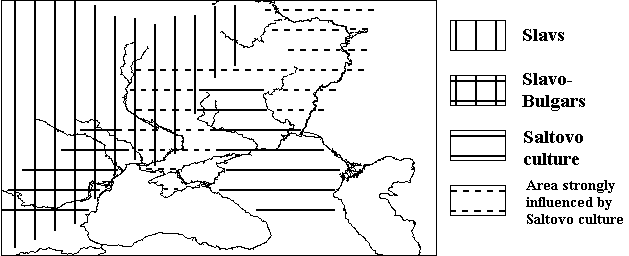
Area of the Saltovo-Majack culture (after M. Gimbutas, 'The Slavs', 1971)
(The map was produced using XEROX Map Viewer)
Because of the fierce Khazaro-Arab wars of VIII c. the sedentary population of central Fore Caucasus moved northwards and settled down in the mixed forest-steppe region along the upper courses of Don and Severski Doneck. Both documentary [4] and archaeological data [5] confirm the harsh treatment of the Caucasian population by the Arabian invaders, which caused the migration. The migrations were probably directed both to the Don steppes and forest-steppes, and to the region of middle Volga and Kama, the territory of the later Volga Bulgaria [6].
Most important, however, was the the intensive process since mid-VIII c. of settling down of the yesterday's nomadic Proto-Bulgarians over the vast territory of Don, Doneck, Crimea and the lands of Azov. The explanation of this phenomenon by Pletnjova is quite convincing - the continuous wars and the increased tributes paid to the Khazars deprived the nomadic Proto-Bulgarians from their major livelihood - the cattle breeding. As a result they had to look for other means for maintenance - the crafts and the agriculture [7]. The process was facilitated by the increasing social stratification in the Proto-Bulgarian society.

Area of the Saltovo-Majack culture (after M. Gimbutas,
'The Slavs', 1971)
(The map was produced using XEROX Map Viewer)
In the mid-VIII c. the Khazarian tribal union developed into a state, with the establishment of permanent settlements and the development of the crafts and agriculture. In a surprisingly short period of time the vast area from Dagestan to Dnepr and from the Fore-Caucasus to the upper courses of Don and Doneck evidenced the birth of a comparatively uniform culture. It is generally accepted that the V-VII c. Sarmato-Alanian culture of Eastern and Central Fore-Caucasus provided the basis of the Saltovo-Majack culture. But the latter culture spread to much larger territory than that inhabited by Alans. Generally, it encompassed the areas occupied by various Proto-Bulgarian tribes. That is why it is universally accepted that it was the work of both Alans and Proto-Bulgarians [8].
Proto-Bulgarians had great contribution to that culture as the same or similar to it culture is found in the other two state formations where they played an important role - Danube Bulgaria and Volga Bulgaria [9]. Ljapushkin distinguishes two variants of the Saltovo-Majack culture on the territory of the Khazarian Khaganate - northern (Alanian) and southern (Proto-Bulgarian), while Pletnjova distinguishes five variants - forest-steppe (northern), Dagestanian, Don-Doneck, Crimean and Azovian [10]. She attributes the first one to the Alans, the second - to the Khazars, and the next three - to the Proto-Bulgarians. In order to obtain a clearer impression about the influence of the Saltovo-Majack culture on Danube Bulgaria, it is important to analyse its three Proto-Bulgarian variants - the Don-Doneck, the Azovian and the Crimean one.
[Previous] [Next]
[Back to Proto-Bulgar Page]
[1] Theophanes. Op. cit., p. 357: " Soon after his (Kubrat's) death his five sons parted and moved apart, each of them with the people he had in his power. And the first son, called Batbajan adhered to his fathers' will and remains in the lands in his forefathers up to the present. The second, his brother, called Kotrag, crossed Tanais (Don) and settled in the lands opposite to his first brother." The finds along the left bank of Dnepr of the type Pereschepino are evidence of the resistance of the Kotrags-Kutrigurs against the Khazars.
[2] I.A. Baranov. Nekotoriie itogi izuchenija tjurko-bolgarskih pamjatnikov Kriima. - Sb. Pliska-Preslav. 2, 1981, s. 57-71.
[3] Theophanes. Op. cit., p. 358: "And after their (of the Bulgars) spliting in five groups and becoming weak in numbers, the large people of the Khazars appeared from the innermost parts of Bersilia and occupied the whole land up to the Pontus. And the first brother Batbajan, the ruler of Bulgaria prima, became their tributary and the Khazars receive tribute even nowadays"
[4] M.I. Artamonov. Istorija khazar, s. 202-232.
[5] V.A. Kuznecov. Alanskie plemena
Severnogo Kavkaza, s. 30;
G.E. Afanasjev. Poselenija VI-IX vv. rajona Kislovodska. - Sovetskaja arheologija,
1975, No 3, s. 60-61.
[6] S.A. Pletnjova. Vostochno-evropejskie stepi vo vtoroj polovine VIII-X vv., s. 77.
[7] S.A. Pletnjova. Ot kochevij k gorodam, s. 20-22.
[8] I.I. Ljapushkin. Pamjatniki
saltovo-majackoj kul'turii v bassejne Dona. - Materialii i issledovanija
po arheologii SSSR, 62, 1958, s. 147;
M.I. Artamonov. Sarkel-Belaja Vezha. - MIA, 62, 1958, s. 45-48;
S.A. Pletnjova. Ot kochevij k gorodam, s. 188.
[9] V.F. Gening, A.H. Halikov.
Rannie bolgarii na Volge. s. 126-131;
E.P. Kazakov. O bolgaro-saltovskom komponente v pogrebal'niih inventarijah
rannej Volzhkoj Bolgarii. - V: Pliska-Preslav. II, s. 127-132.